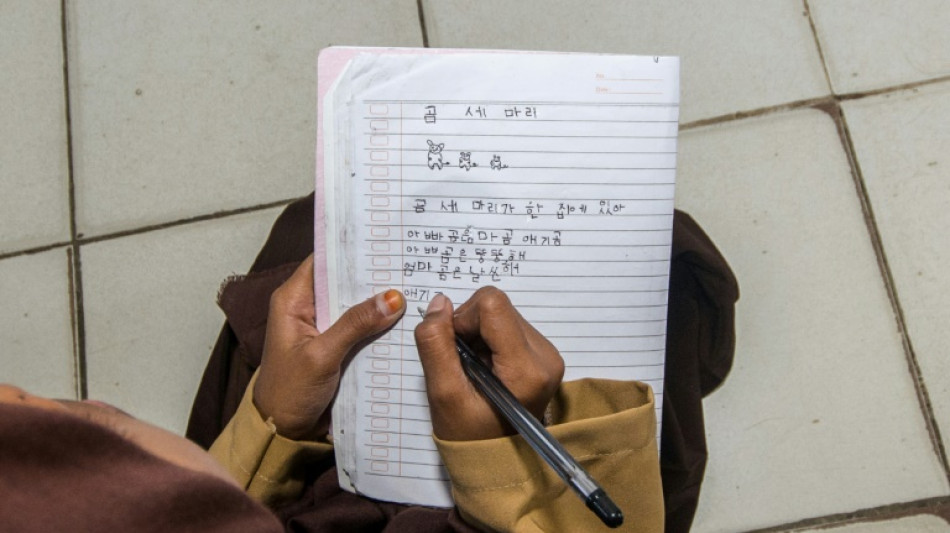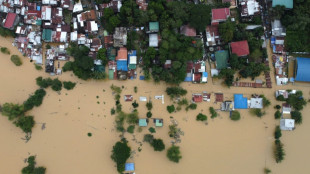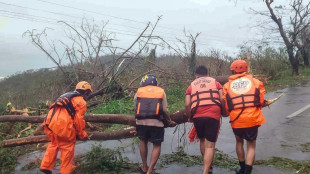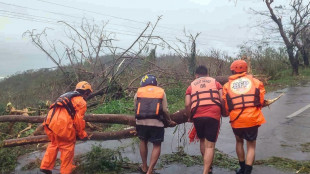
-
 Russian extradited to US from SKorea to face ransomware charges
Russian extradited to US from SKorea to face ransomware charges
-
Phone documentary details Afghan women's struggle under Taliban govt

-
 G20 wrestles with wars, 'turbulence' in run-up to Trump
G20 wrestles with wars, 'turbulence' in run-up to Trump
-
Kane hoping to extend England career beyond 2026 World Cup

-
 Gazans rebuild homes from rubble in preparation for winter
Gazans rebuild homes from rubble in preparation for winter
-
'Vague' net zero rules threaten climate targets, scientists warn

-
 Stocks, dollar hesitant as traders eye US rate outlook, Nvidia
Stocks, dollar hesitant as traders eye US rate outlook, Nvidia
-
G20 wrestles with wars, climate in run-up to Trump

-
 'Agriculture is dying': French farmers protest EU-Mercosur deal
'Agriculture is dying': French farmers protest EU-Mercosur deal
-
Beyonce to headline halftime during NFL Christmas game

-
 Rescuers struggle to reach dozens missing after north Gaza strike
Rescuers struggle to reach dozens missing after north Gaza strike
-
Russia vetoes Sudan ceasefire resolution at UN

-
 G20 host Brazil launches alliance to end 'scourge' of hunger
G20 host Brazil launches alliance to end 'scourge' of hunger
-
Stocks, dollar hesitant as traders scale back US rate cut bets

-
 Trump confirms plan to use military for mass deportation
Trump confirms plan to use military for mass deportation
-
Schools closed in Beirut after deadly Israeli air raid

-
 Anger, pain in Turkey as 'newborn deaths gang' trial opens
Anger, pain in Turkey as 'newborn deaths gang' trial opens
-
Kremlin says Biden 'fuelling' war as Russian strikes rock Odesa

-
 UN climate chief at deadlocked COP29: 'Cut the theatrics'
UN climate chief at deadlocked COP29: 'Cut the theatrics'
-
G20 leaders gather to discuss wars, climate, Trump comeback

-
 Stocks, dollar mixed as traders scale back US rate cut bets
Stocks, dollar mixed as traders scale back US rate cut bets
-
Stoinis lets rip as Australia crush Pakistan for T20 series whitewash

-
 Bentancur banned for seven games over alleged racial slur
Bentancur banned for seven games over alleged racial slur
-
Kremlin says Biden 'fuelling' tensions with Kyiv missile decision

-
 COP host Azerbaijan jailed activists over 'critical opinions': rights body
COP host Azerbaijan jailed activists over 'critical opinions': rights body
-
Composer of Piaf's 'Non, je ne regrette rien' dies aged 95

-
 South African trio nominated for World Rugby player of year
South African trio nominated for World Rugby player of year
-
'Not here for retiring': Nadal insists focus on Davis Cup

-
 Tractor-driving French farmers protest EU-Mercosur deal
Tractor-driving French farmers protest EU-Mercosur deal
-
Floods hit northern Philippines after typhoon forces dam release

-
 Pakistan skittled for 117 in final T20 against Australia
Pakistan skittled for 117 in final T20 against Australia
-
Schools closed in Beirut after deadly Israeli strike

-
 Chris Wood hits hat-trick in NZ World Cup qualifying rout
Chris Wood hits hat-trick in NZ World Cup qualifying rout
-
Markets mixed after Wall St losses as traders weigh US rates outlook

-
 US, Philippines sign deal on sharing military information
US, Philippines sign deal on sharing military information
-
Bangladeshi ex-ministers face 'massacre' charges in court

-
 Law and disorder as Thai police station comes under monkey attack
Law and disorder as Thai police station comes under monkey attack
-
Disgraced Singapore oil tycoon sentenced to nearly 18 years for fraud

-
 Philippines cleans up as typhoon death toll rises
Philippines cleans up as typhoon death toll rises
-
Quincy Jones awarded posthumous Oscar

-
 'Critically endangered' African penguins just want peace and food
'Critically endangered' African penguins just want peace and food
-
Long delayed Ukrainian survival video game sequel set for release amid war

-
 Star Australian broadcaster charged with sex offences
Star Australian broadcaster charged with sex offences
-
Philippines cleans up after sixth major storm in weeks

-
 Woman-owned cafe in Indonesia's Sharia stronghold shakes stigma
Woman-owned cafe in Indonesia's Sharia stronghold shakes stigma
-
Indigenous Australian lawmaker who heckled King Charles censured

-
 End of an era as Nadal aims for winning Davis Cup farewell
End of an era as Nadal aims for winning Davis Cup farewell
-
Trump taps big tech critic Carr to lead US communications agency

-
 Mitchell-less Cavs rip Hornets as perfect NBA start hits 15-0
Mitchell-less Cavs rip Hornets as perfect NBA start hits 15-0
-
Markets swing after Wall St losses as traders weigh US rates outlook


Indigenous Indonesians use Korean letters to save dialect
In an eastern Indonesian village, schoolchildren scrawl the distinctive circles and lines of Hangul script on a whiteboard, but the language they are learning is not Korean. It is their own Indigenous Cia-Cia tongue.
The language of the Cia-Cia ethnic group in southeast Sulawesi province's Baubau has no written form, and the syllable-based tongue does not readily translate to the Latin alphabet often used to transcribe Indonesia's national language.
But the Korean Hangul script, developed in the 15th century, shares a syllable-based system that has made it an unusual tool in the effort to preserve and transmit the language of the approximately 80,000 Cia-Cia people.
"In Latin words, for instance, there's no agreed way to pronounce the sounds 'pha' or 'ta'. But after I learned Korean, it turns out there are Korean characters for the sounds," 48-year-old teacher Abidin, who goes by one name, told AFP.
"They are not exactly the same, but they're similar."
Indonesia is a vast archipelago nation with myriad tribes and cultures that boasts more than 700 unique languages, making it one of the most linguistically diverse nations in the world.
The country's official language is Bahasa Indonesia, which owes its standard written form using Latin letters to Dutch colonial rule.
But the Cia-Cia's language had no surviving written form until 2009, when Hangul was introduced after a cultural exchange between Baubau city and Korean scholars.
The decision was the outcome of a concerted push by South Korean linguists, who visited to tout Hangul's sound-based system as the perfect fit.
After the visit, the city sent teachers and students to South Korea to learn Hangul with the goal of developing a standard way to write and teach their language.
- Preservation efforts -
In ancient times, leaders of the community committed the language to scraps of paper and wood using non-standard symbols that were never passed down and withered away.
But now Cia-Cia names dot the city's schools, streets and government institutions, rendered in Hangul.
The tongue is also taught to students from elementary to high school using Hangul symbols, though it remains largely a spoken rather than written language.
Abidin spent six months in South Korea training on Hangul, and is seen as a pioneer of transcribing Cia-Cia in the script. He has even penned a dictionary for the language using Hangul.
Hangul is viewed with great pride in South Korea, where it was once banned under Japanese rule, and word of the script's role in Indonesia has been hailed by some politicians and newspapers as proof of the writing system's global presence.
Its adoption by the Cia-Cia illustrated a fierce desire to preserve their language, said linguist Dalan Mehuli Perangin-angin at Indonesia's Sanata Dharma University.
"This shows that there is a longing from the people for their own script," he said.
Even the spoken form of Cia-Cia faces pressure from the dominance of Bahasa Indonesia and other regional languages, said Ilyas, a local elder, who goes by one name.
"Many words have been lost due to the influence of Indonesian and other regional languages. This has been happening for about 20 years," the 50-year-old said.
Fears about their language's future prompted elders to accept the use of Hangul, but some do have concerns.
- Language legacy -
Baubau is the only place in Indonesia to use Hangul, and while the South Korean push for the script is not backed by Seoul, its nationalist tint could blur the community's identity, said Periangin-angin.
"Language contains memories, history, morality, and wisdom of our ancestors. A language script is a legacy," he said.
He suggests the Cia-Cia could have adopted a script already used by another dialect in Sulawesi, which would have had closer linguistic links.
But for Sarianto, who was among the students who learned Hangul in South Korea, the script has "sparked the creation of new discourses dedicated to the preservation of the Cia-Cia language".
"Before the introduction of Hangul, many of Cia-Cia people used to feel a bit hesitant about using the local language in formal settings," he said.
"However, with the implementation of Hangul, people say our Cia-Cia language has become global."
R.Chavez--AT


